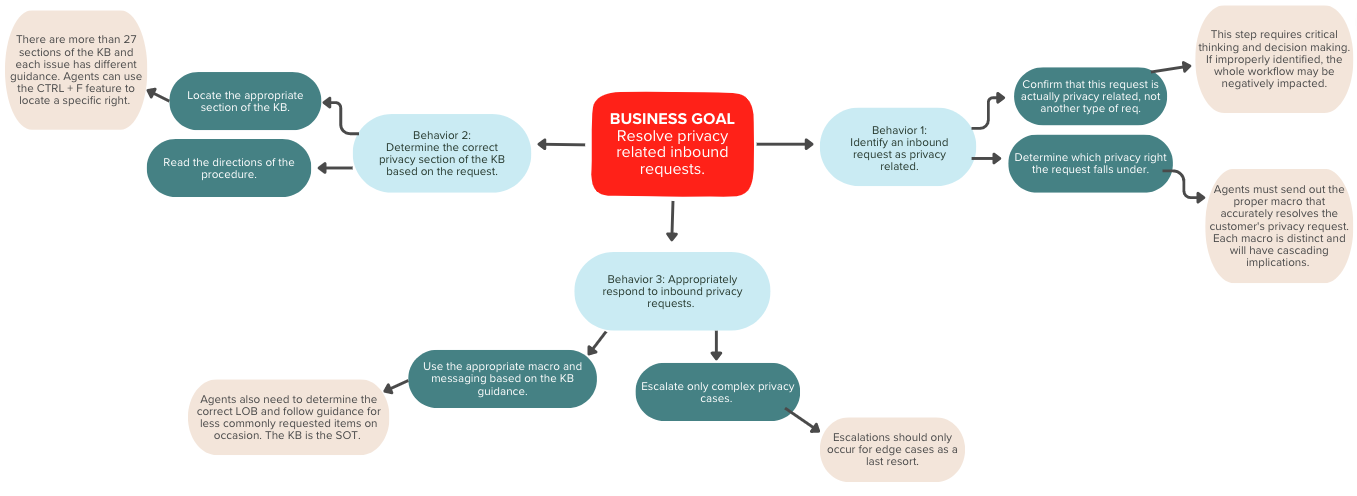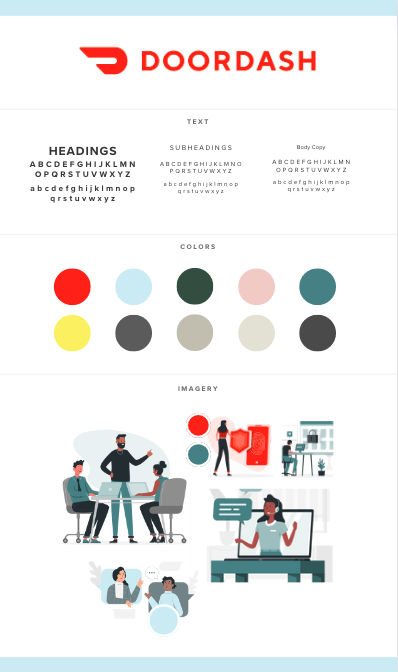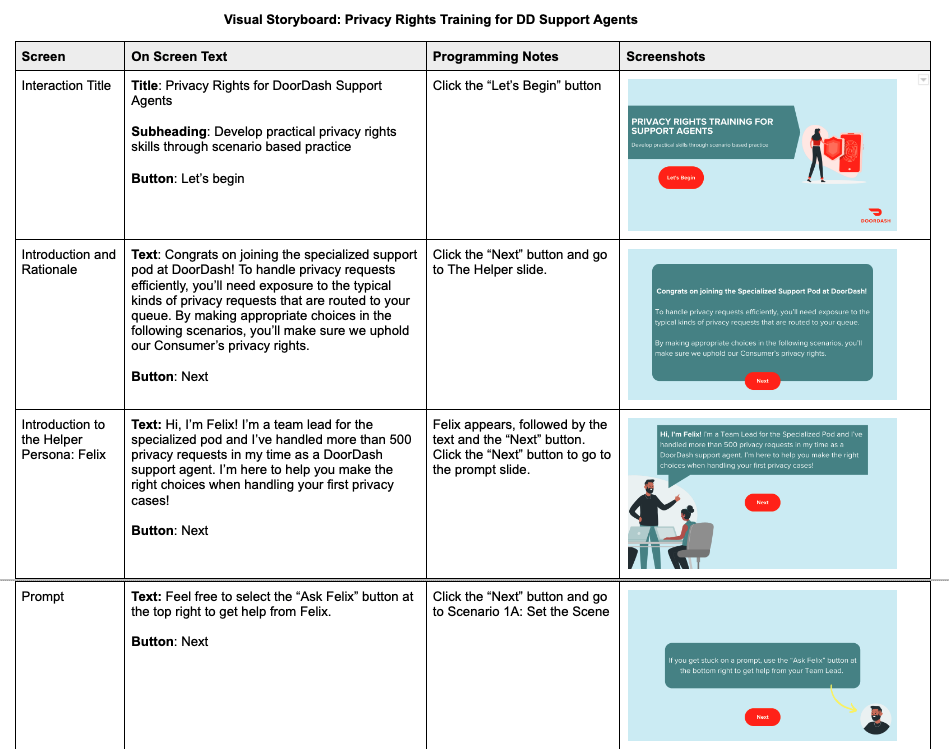Privacy E-Learning for DoorDash Support Agents
This is a scenario-based learning experience designed for DoorDash customer support agents to resolve privacy related customer requests.
Audience: DoorDash customer support agents who work on specialized Health, Safety, and Legal (HSL) cases.
Responsibilities: Instructional Design, eLearning Development, and Visual Design
Tools Used: Articulate 360, Canva, Camtasia
Time Spent: 1 month
Experience the Project
Part one is a short Rise course that introduces the 6 most common privacy concepts.
Part two is a scenario based privacy training built in Storyline.
Business Problem
As public awareness around online data expands, so does the need for technology companies, like DoorDash, to respond to privacy-related customer requests. Over the course of a year, the DoorDash privacy team noticed an influx of privacy requests being routed to their direct inbox rather than being resolved by customer support agents. This problem was leading to confusion, delayed response times, surmounting legal fees, and, at times, the loss of customers.
Design question: How might DoorDash better respond to customers’ growing data privacy requests?
Research Efforts
I worked directly with the DoorDash privacy team to explore the problem and determine the correct course of action to resolve the issue.
Here were the findings:
-
87% of total cases are eligible to be handled by the support agents, but only 7% of eligible cases are actually solved by that team.
-
For each unresolved privacy request, the consequences are high, such as government fines and legal fees from customer lawsuits.
-
There are more than 27 privacy rights that DoorDash must legally abide by. At the time, DoorDash did not have explicit guidance documents on how to respond to privacy requests. This lack of documentation led to a disproportionate number of cases routed directly to the Privacy team.
-
Although highly experienced and trained, the DoorDash support agents did not have any formal training on clear steps to take when handling an inbound privacy request.
Proposed Solutions
Create an official guidance document that explicitly outlines how support agents should respond to all 27 different privacy requests.
Create a self guided learning experience for support agents to improve their efficacy when handling privacy issues.
Training Approach
My goal was to train the DoorDash support agents to independently resolve more privacy requests. I proposed to design an eLearning solution that would help learners identify inbound privacy requests and take action toward a resolution. Inspired by Cathy Moore’s scenario-driven activity approach, I created a series of eLearning experiences where learners could make decisions about how to handle privacy issues in a safe practice environment.
Metrics of Success
Increase the first contact resolution rate (FCR) for privacy-related issues by 30%.
Decrease the amount of email inquiries sent to the legal team by 30%.
Process
I consulted with SMEs (a DoorDash legal expert and a DoorDash privacy content specialist) to identify the knowledge gaps, create a task analysis, and elicit feedback on the course outlines, storyboards, prototypes, and final training deliverables. I designed this course by using a combination of task analysis and action mapping to define the learning objectives and outline the concrete steps that support agents need to take to resolve a privacy case. I created visual mockups in Canva, wrote several iterations of the storyboard and scripts, built the prototypes, and developed the end product in Articulate Storyline and Rise.
Action Map
I consulted with the privacy and legal SMEs to identify what the support agents must do to properly resolve privacy cases. Working together, we broke down each observable behavior into substeps and listed potential pitfalls and consequences. Through action mapping, we were able to brainstorm potential training scenarios.
After action mapping, I recommended that we take a two prong training approach:
Create an interactive Rise course that clearly outlines the legal information that must be applied on the job.
Create an interactive Storyline experience to allow learners to practice in a low-stakes, simulated performance environment.
In her book, Map It: The Hands-On Guide to Strategic Training Design, Cathy Moore recommends creating branching scenarios that focus on what learners actually need to do on the job. She says that, “Even though it’s just an imaginary situation, [scenario-based practice] requires [learners] to go beyond simply retrieving information and apply it to a realistic situation.” Using this approach as a guide, I designed a scenario-forward collection of learning experiences.
Text Based Storyboards
Using the action map, I created text based storyboards for the Rise and Storyline sections of the course. I designed six scenarios that illustrated the most common privacy requests that a support agent will expect to see on the job. Each short scenario included a common privacy request and a few possible options the learner could take. Working with the SMEs, I drafted possible consequences that might occur when making an incorrect decision. Feedback for incorrect decisions were designed to be motivating rather than punitive, so that learners felt encouraged to continue on and make the correct decision down the road.
Branding Elements and Visual Assets
Using DoorDash branding standardization as a guide, I created a moodboard to inspire the creative direction of the course. I used Canva to collect the visual assets and colors I planned to use in the course.
Visual Storyboards
I created visual storyboards to align the graphic elements with the on screen text, which helped me prepare to build the high fidelity prototype.
Iteration
After creating the visual prototypes, I gathered feedback from SMEs and stakeholders. With the visual elements in place, stakeholders were able to experience the practice scenarios as a learner would. I also was able to elicit recommendations from two Specialized Pod support agents who were the target audience for the eLearning. They provided some suggestions to include more explicit guidance from the Helper Persona, Felix. I iterated on the eLearning and implemented the changes based on the feedback.
Final Product and Measuring Success
After about a month of development, I published the course to the DoorDash LMS. The course rolled out in tandem with the new privacy rights guidance document.
In the months following the training launch, the privacy team was able to report that we had exceeded the original target metrics:
Increased the first contact resolution rate (FCR) for privacy-related issues by 30.25%. (Original goal was 30%)
Decreased the amount of email inquiries sent to the legal team by 36.44%. (Original goal was 30%).
The course itself currently has a 91% pass rate and a 94% course satisfaction rate from over 200 learners who have taken the course.
Stakeholder Feedback
Feedback from SMEs
We’re really happy with how Stephanie was able to make all of this incredibly dense legal jargon into a bite-sized, comprehensible course.
Amazing job on the HSL Privacy training. The training looks fantastic and our teammates are going to get a lot out of this course.
We just showed the course to the entire privacy team and they agreed it was the best privacy training they had ever seen. Only great things to say!
Feedback from Learning Experience Design Manager
Great job with this course! The scenarios are spot on and really get the learner to engage with the actual work activity. “A Real-Life Example” is a great way of relating the subject matter to real life (learners’ background knowledge outside of work). All of your activities are easy to follow. Even in the free response question, you made it clear in the instructions to copy+paste it from the KB. Really well done.
Feedback from Senior Learning Experience Designer
The course follows a great flow and uses a variety of activities to keep the learner engaged. Connecting the learners to a real-life example of how privacy can impact them and the business was a great addition to the course. It shows what’s at stake while handling these types of issues. Your quiz at the end is perfect for gauging the learners’ ability to apply their knowledge to job-related tasks. Great job using a real-life email example in the knowledge check. This demonstrates job-related skill acquisition and definitely reflects your learning objectives.
Areas to Improve
Stick to consistent use of stock imagery in the “Real Life” story section of the course.
Aim to future-proof two of the knowledge check questions. If the guidance documentation changes, the questions will also need to be updated.
Consider adding even more practice scenarios to the Storyline interaction.





